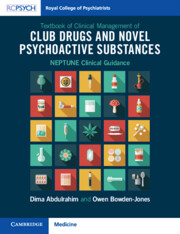 Textbook of Clinical Management of Club Drugs and Novel Psychoactive Substances
Textbook of Clinical Management of Club Drugs and Novel Psychoactive Substances Book contents
- Textbook of Clinical Management of Club Drugs and Novel Psychoactive Substances
- Textbook of Clinical Management of Club Drugs and Novel Psychoactive Substances
- Copyright page
- Contents
- Acknowledgements
- Part I Introduction and Background
- Part II Drugs with Primarily Depressant Effects
- Part III Drugs with Primarily Stimulant Effects
- Chapter 8A Introduction to Stimulant Club Drugs and Novel Psychoactive Substances
- Chapter 8B Amphetamine-type Stimulants: An Overview
- Chapter 9 ‘Ecstasy’: MDMA (3,4-Methylenedioxy-N-Methylamphetamine), MDMA Analogues and Drugs with Similar Effects
- Chapter 10 Methamphetamine
- Chapter 11 Synthetic Cathinones
- Part IV Drugs with Primarily Hallucinogenic Effects
- Part V Synthetic Cannabinoid Receptor Agonists
- Part VI Concluding Remarks
- Index
Chapter 8A - Introduction to Stimulant Club Drugs and Novel Psychoactive Substances
from Part III - Drugs with Primarily Stimulant Effects
Published online by Cambridge University Press: 06 October 2022
- Textbook of Clinical Management of Club Drugs and Novel Psychoactive Substances
- Textbook of Clinical Management of Club Drugs and Novel Psychoactive Substances
- Copyright page
- Contents
- Acknowledgements
- Part I Introduction and Background
- Part II Drugs with Primarily Depressant Effects
- Part III Drugs with Primarily Stimulant Effects
- Chapter 8A Introduction to Stimulant Club Drugs and Novel Psychoactive Substances
- Chapter 8B Amphetamine-type Stimulants: An Overview
- Chapter 9 ‘Ecstasy’: MDMA (3,4-Methylenedioxy-N-Methylamphetamine), MDMA Analogues and Drugs with Similar Effects
- Chapter 10 Methamphetamine
- Chapter 11 Synthetic Cathinones
- Part IV Drugs with Primarily Hallucinogenic Effects
- Part V Synthetic Cannabinoid Receptor Agonists
- Part VI Concluding Remarks
- Index
Summary
Substances with a stimulant effect have been used by successive generations of people. A wide range of substances have been used, notably of course caffeine and nicotine. Psychostimulants can be plant-based substances or can also be of a synthetic nature.
- Type
- Chapter
- Information
- Textbook of Clinical Management of Club Drugs and Novel Psychoactive SubstancesNEPTUNE Clinical Guidance, pp. 143 - 145Publisher: Cambridge University PressPrint publication year: 2022
